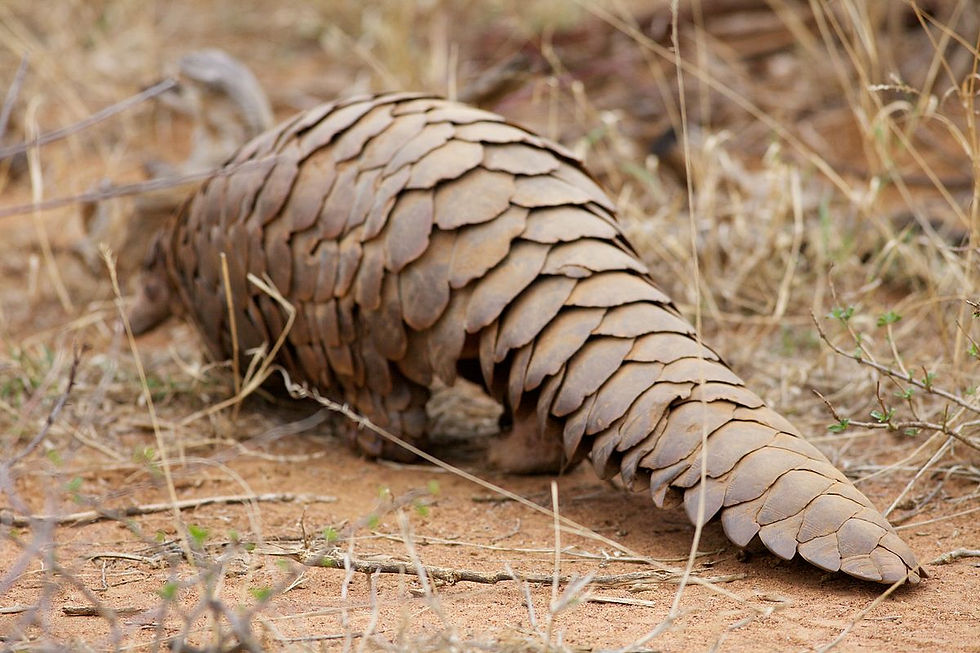What's a pangolin?
- Jessica Evans
- Feb 20, 2019
- 3 min read
It’s dusk. You’re outside, basking in the cool evening and the audible harmony of insects and frogs. You’re on a sizeable plot of land and there is bush all around you. Perhaps you’re on a game drive, or at a game lodge, or on your stoep watching the sky graduate from its usual hue to electric blues, pinks and flame. Maybe you can smell a fire in the distance – a domestic one; a braai maybe.
The grass rises out of the orange sand long and pastel yellow and you can hear it brush against itself in the slight breeze. Everything is awake and buzzing and lively, yet peaceful.
"Everything is awake"
The evening goes on. Most birds flutter about, hurriedly getting their last mouthfuls before they retire to the tree tops. Bats, owls and nightjars begin to emerge as the heat of the day starts to dissipate quickly.
The fiery colours leave the sky and are replaced by cool blues. The further your eyes stray from the horizon, the more richer, darker blues you find, with a velvety royal blue at the centre of the sky, and darkness beyond.
I should get inside soon, you begin to think.
But you hear the slightest almost indiscernible crunch out there in the late evening and your eyes drift over to it.
"Scales? Yes, scales!"
You don’t see it at first, but then you catch a glimpse. Scales? Yes, scales! They move smoothly through the flora, echoing your childhood imaginings of mermaids weaving through deep-sea forests.
You spot the tiny face, stuck quite awkwardly on the tip of the animal’s long pointed carapace.
It passes so gently and with such subtlety you’re moved. You find yourself in awe of this rare and strange collection of parts going about its life before you. You have to find out what it is.
It’s a pangolin, the most trafficked animal on earth.

An African pangolin at Madikwe Game Reserve, South Africa.
The 16th of February was World Pangolin Day. The pangolin is a kind of ant-eater found in Africa and Asia. There are eight species of pangolin – four in Asia and four in Africa. They live in a range of habitats, including savannah grassland, and can range in size from about 30 cm to one metre in length.
"The pangolin is a kind of ant-eater found in Africa and Asia"
They’re nocturnal, and when they aren’t foraging for ants using their claws and insanely long tongue, African species can be found nesting in burrows or trees, depending on the species.
Pangolins are solitary, covert animals, making it difficult for scientists to study them, but we do know that pangolins, and their undying hunger for insects, makes them vital for pest control in their ecosystems. We also know that they evolved scales as a defence mechanism against predators, much like an armadillo.
"Pangolins are solitary, covert animals, making it difficult for scientists to study them"
Pangolin scales are made of keratin, just like human hair and fingernails. Their scales are used in the far east for medicinal and superstitious purposes, a lot like rhino horn, and their meat is considered a delicacy.
Although you might associate scales with fish or reptiles, pangolins are actually mammals. This means they’re warm blooded, and the moms feed their babies with milk that comes from their mammary glands.
Speaking of babies, they typically have just one at a time, making the population even more vulnerable to disappearing.
You may ask yourself, so what? I mean, pangolins disappearing won’t affect you all that much. That may be so, but if you care at all about the preservation of ecosystems all over the world, you should care about pangolins.
"You may ask yourself, so what?"
They provide important ecosystem services wherever they are and their absence will have knock-on effects throughout the food web.
So how can you help?
- You can donate to Pangolin.Africa.
- And you can contribute to scientific understanding of the geographical distribution of these animals while also reporting pangolins in distress using pangolert.
#Whatsapangolin #pangolin #africanpangolin #16february #worldpangolinday #worldsmosttraffickedanimal #madikwegamereserve #southafrica #anteater #8species #AfricanWildlifeFoundation #PangolinAfrica #pangolert #bitesizedsci #incrediblecritters #mammal #scales #keratin #wildlifetrade #illegalwildlifetrade #ecosystemservices #howcanyouhelp






Comments